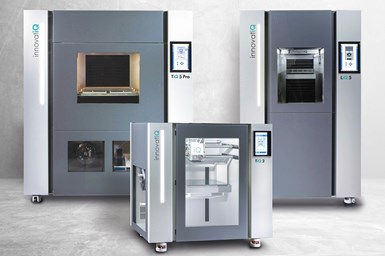Compact TiQ Series Offers Versatile 3D Printing for Fiber-Reinforced Filaments
Formnext 2023: The TiQ 2 is particularly economical and well suited as an entry-level additive manufacturing solution because of its open material system.
Share
The TiQ and LiQ series 3D printers from InnovatiQ are well suited for processing fiber-reinforced filaments and standard silicones. Photo Credit: innovatiQ
Arburg Additive and innovatiQ (an Arburg brand) offer a range of products for industrial additive manufacturing (AM) based on granulates, filaments and liquid silicone (LSR). The TiQ and LiQ series of 3D printers from innovatiQ can process fiber-reinforced filaments and certified LSR.
The TiQ series of printers are well suited for fiber-reinforced filaments. The compact 3D printers in the TiQ series have a CNC control system for processing filaments using the fused filament fabrication (FFF) process. The company says the TiQ 2 is economical and well suited as a versatile, entry-level AM solution because of its open material system. It features loadable suction pads and mechanical grippers made of fiber-reinforced PA and PP with individualized fingers that are mounted on robot arms and used for picking up components.
The TiQ 5 Pro has integrated material drying and an active build chamber temperature control. Featuring a build chamber of 500 × 400 × 450 mm, it is a 3D manufacturing machine for large components in an extra large format. Its versatility includes handling hard or soft material as well as high-performance polymers requiring a heated build chamber and filaments that require process drying. It is also suitable for the economical printing of large components made of fiber-reinforced or high-temperature materials.
The printer has an actively heated process chamber that can be operated at temperatures of up to 155°C. This enables particularly demanding materials to be processed in the 500 × 400 × 450 mm dimension. The integrated material drying unit keeps hydrophobic filament in the necessary drying state. Material drying increases process reliability and supports the surface quality of the printed components.
All 3D printers from innovatiQ are operated using the intuitive industrial controller GestiQ-Pro. The optional SmartMonitoring system enables several printers to be monitored simultaneously during production. Liquid additive manufacturing (LAM) technology can be used to print items such as bellows, soft grippers and end-of-arm tooling (EoAT) for automation, as well as industrial seals and nozzle closures in various Shore hardnesses — all with high process reliability.
- Read about the opening of Arburg’s Faberlab Additive Center in Italy. The goal for the center is to demonstrate the potential of industrial additive manufacturing to prospective and existing customers of 3D printing technology on real machines.
- Learn more about Arburg technology with its Freeformer 750-3X 3D which features a larger build chamber, providing more space inside the build chamber for larger components.
Related Content
10 Important Developments in Additive Manufacturing Seen at Formnext 2022 (Includes Video)
The leading trade show dedicated to the advance of industrial 3D printing returned to the scale and energy not seen since before the pandemic. More ceramics, fewer supports structures and finding opportunities in wavelengths — these are just some of the AM advances notable at the show this year.
Read MoreWhat We Found at Formnext 2023
New metal processes, new possibilities for existing processes, the next step for copper and more. Here is a summary drawing on all our reporting from November’s event.
Read MoreFormnext 2022: Ceramics, Robots and Other Perspectives From Near and Far: AM Radio #30
The 2022 edition of Formnext revealed more options and applications for 3D printed ceramics, anticipation of coming automation, established companies entering AM and more. Two editors — one present at the show, and one observing from a distance — compare notes in this episode of AM Radio.
Read MoreFinland’s Largest Metal 3D Print Withstands Pressure Vessel Test, Vastly Exceeding Expectations
The pressure vessel was created in cooperation between Andritz Savonlinna Works and the Finish Additive Manufacturing Ecosystem (FAME), and withstood the nondestructive and destructive tests carried out by LUT University.
Read MoreRead Next
Hybrid Additive Manufacturing Machine Tools Continue to Make Gains (Includes Video)
The hybrid machine tool is an idea that continues to advance. Two important developments of recent years expand the possibilities for this platform.
Read More4 Ways the Education and Training Challenge Is Different for Additive Manufacturing
The advance of additive manufacturing means we need more professionals educated in AM technology.
Read More3D Printing Brings Sustainability, Accessibility to Glass Manufacturing
Australian startup Maple Glass Printing has developed a process for extruding glass into artwork, lab implements and architectural elements. Along the way, the company has also found more efficient ways of recycling this material.
Read More









.png;maxWidth=300;quality=90)














